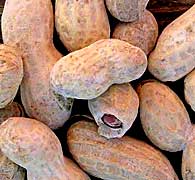


Home
Flowers &
Indoor Plants
Fruits & Nuts
Ornamentals
Vegetables
Special Topics
Resources
Glossary

|
Peanut Arachis hypogaea (ah-ray-kis hye-poh-zhee-ah) 


Click on thumbnails for larger image. |
 |
What about it? The peanut plant is a member of the pea family, and the peanut is really a seed, not a nut at all! Peanuts are leguminous plants which fix nitrogen into the soil; they are actually vines that grow above ground. Peanuts produce their seeds on long pegs that descend from the flower. These pegs bend down and penetrate the earth to produce the seeds. The pods grow underground and contain the edible seeds which we refer to as peanuts. Although home gardeners occasionally try growing them here in the Northeast, the peanut performs the best in the sunny South. What is it used for? Peanuts are an excellent source of protein and are commonly enjoyed by children and adults alike. Some well known favorites include peanut butter, peanut brittle and chocolate-covered peanuts. They are also roasted and eaten alone. Where does it grow? How do we grow it? Peanuts need hot summers at least four months long; they can tolerate no frost. They also require full sun and a well-drained, slightly acid soil. Because peanuts grow underground, they require light soil that is easy to penetrate. Peanuts should be planted 4 inches apart. What are its primary problems? Weeds are usually the major pest problem affecting peanuts in home gardens. The most common pests are thrips, cutworms, corn earworms, spider mites, and various caterpillars. Peanuts are susceptible to a few diseases. Leaf spot, southern blight, and pod rots are the most common diseases. How do we harvest and store it? Peanuts are ripe when they look well-formed; the insides of the pods will contain dark-colored veins. The foliage of the plant will turn yellow, too. Cure harvested peanuts by leaving the plants in a warm, dry place for several weeks.
© Copyright, Department of Horticulture, Cornell University. |